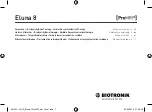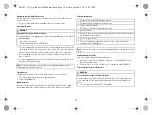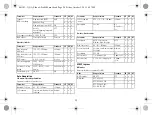
en • English
9
Arrhythmia or ventricular fibrillation can be induced during diathermic procedures
such as electrocautery, HF ablation or HF surgery. For example, damaging pressure
levels may arise during lithotripsy. Influences on the device are not always immediately
clear.
If potentially risky procedures cannot be avoided, the following should be observed at
all times:
• Electrically insulate patients.
• Switch the pacemaker function to asynchronous modes if needed.
• Do not introduce energy near the device system.
• Check the peripheral pulse of the patient.
• Monitor the patient during and after every intervention.
External defibrillation
The device is protected against the energy that is normally induced by external defibril-
lation. Nevertheless, any implanted device may be damaged by external defibrillation.
Specifically, the current induced in the implanted leads may result in necrotic tissue
formation close to the electrode/tissue interface. As a result, sensing properties and
pacing thresholds may change.
• Place adhesive electrodes anterior-posterior or perpendicular to the axis formed
by the device to the heart at least 10 cm away from the device and from implanted
leads.
Radiation therapy
The use of radiation therapy must be avoided due to possible damage to the device and
the resulting impaired functional safety. If this type of therapy is to be used anyway,
prior risk/benefit analysis is absolutely necessary. The complexity of influencing
factors such as different sources of radiation, a variety of devices and therapy condi-
tions makes it impossible to issue directives that guarantee radiation therapy without
an impact on the device. The EN 45502 standard pertaining to active implantable
medical devices requires the following measures during the administration of thera-
peutic ionizing radiation:
• Adhere to instructions for potentially risky therapeutic and diagnostic procedures.
• Shield device against radiation.
• After applying radiation, double-check the device system to make sure it is func-
tioning properly.
Magnetic resonance imaging
Magnetic resonance imaging must be avoided due to the associated high frequency
fields and magnetic flux density: Damage or destruction of the device system by strong
magnetic interaction and damage to the patient by excessive warming of the body
tissue in the area surrounding the device system.
Under certain conditions and when maintaining mandatory measures, magnetic
resonance imaging can be performed to protect patient and device system. BIOTRONIK
devices with the "MR conditional function bear the identification ProMRI
®
.
• The ProMRI
®
manual – MR conditional device systems – contains detailed informa-
tion on safely conducting an MRI.
— Download the digital manual from the web site:
manuals.biotronik.com
— Order the printed manual at BIOTRONIK.
• Does approval as "MR-Conditional" apply in your country or region? Ask for current
information at BIOTRONIK.
3 Implantation
Implantation Procedure
Having parts ready
The following parts that correspond to the requirements of the EC Directive 90/385/EEC
are required:
• Device with screwdriver from BIOTRONIK
• BIOTRONIK leads and lead introducer set
— Single-chamber device: unipolar or bipolar lead for the right ventricle
— Double-chamber device: one unipolar or bipolar lead each for the atrium and
for the right ventricle
— Triple-chamber device: an additional unipolar or bipolar LV lead
• Approved connections are IS-1: Use only adapters approved by BIOTRONIK for
leads with different connections or leads from other manufacturers.
• BIOTRONIK programmer (with integrated SafeSync RF telemetry or with separate
SafeSync Module) and approved cables
• External multi-channel ECG device
• Keep spare parts for all sterile components.
Note:
Please contact BIOTRONIK with questions on the risk/benefit analysis.
401303--G_GA_Eluna-I-ProMRI_mul.book Page 9 Friday, October 2, 2015 4:57 PM











































